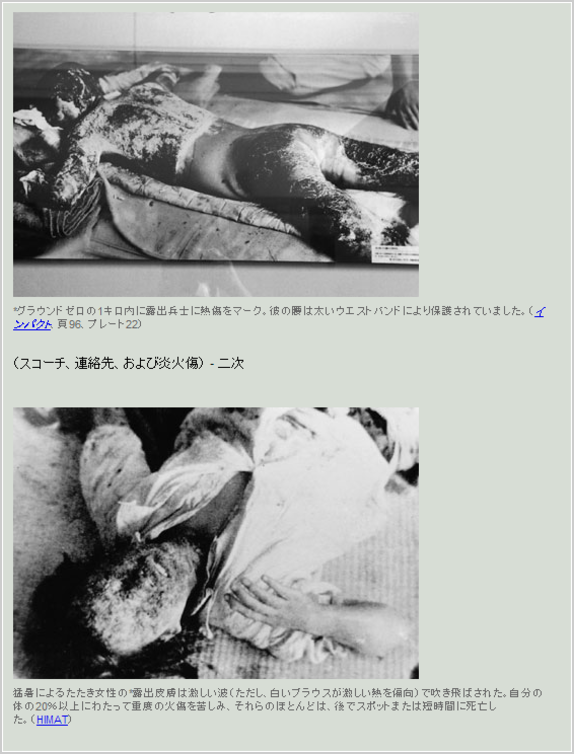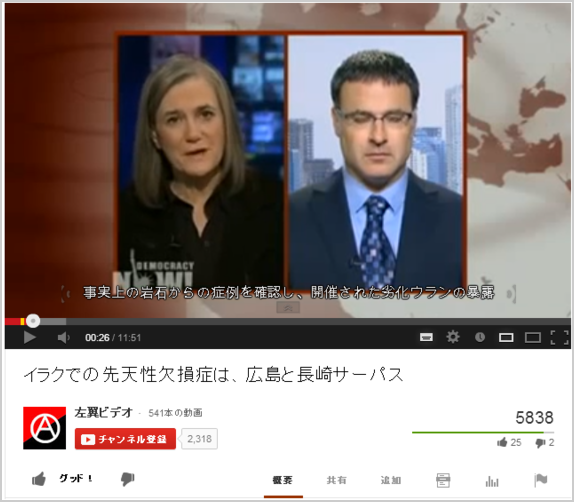Health Effects
- Current Japanese situation 731部隊、広島長崎、チェルノブイリ、福島
- 1945/8/6 広島の記録
- 広島・長崎の反射
- チェルノブイリの健康影響
Birth defects among the children of atomic-bomb survivors (1948 ...
広島・長崎の記録
TOP > 記事:広島・長崎原爆で...
広島・長崎原爆で奇形児が少なかった理由のカラクリ
tacodayoのブログ
URL:blog.livedoor.jp/tacodayo/archives/6576065.html
登録日時:2013-06-10 13:38 | サイト情報:blog.livedoor.jp

広島・長崎原爆で奇形児が少なかった訳=カラクリ 3 長崎、広島原爆で奇形児が一人も生まれなかったという大嘘 長崎、広島原爆で奇形児が一人も生まれなかったという大嘘 2 他を、まとめてみました。 「原爆ホロコースト」の実態 ~ 「原爆」と「冷戦」の舞台裏 ~ ●広島大学の名誉教授である芝田進午氏は、原爆の対日使用は「人体実験」だったとして、1994年に次のように述べている。
広島・長崎原爆で奇形児が少なかった理由のカラクリ
カテゴリ:原発
当ブログの
広島・長崎原爆で奇形児が少なかった訳=カラクリ
広島・長崎原爆で奇形児が少なかった訳=カラクリ 2
広島・長崎原爆で奇形児が少なかった訳=カラクリ 3
長崎、広島原爆で奇形児が一人も生まれなかったという大嘘
長崎、広島原爆で奇形児が一人も生まれなかったという大嘘 2
他を、まとめてみました。
以下は
「原爆ホロコースト」の実態 ~ 「原爆」と「冷戦」の舞台裏 ~
からの引用です。
●広島大学の名誉教授である芝田進午氏は、原爆の対日使用は「人体実験」だったとして、1994年に次のように述べている。
「広島・長崎への原爆攻撃の目的は何だったのか。1つには戦後世界でのアメリカの覇権確立である。そしてもう1つは、原爆の効果を知るための無数の人間への『人体実験』である。
だからこそ、占領後にアメリカ軍が行なったことは、
第1に、原爆の惨状についての報道を禁止し、『人体実験』についての情報を独占することだった。
第2に、史上前例のない火傷、放射能障害の治療方法を必死に工夫していた広島・長崎の医者たちに治療方法の発表と交流を禁止するとともに、死没被爆者のケロイドの皮膚や臓器や生存被爆者の血液やカルテを没収することだった。
第3に、日本政府をして国際赤十字からの医薬品の支援申し出を拒否させることだった。たしかに、『実験動物』を治療するのでは『実験』にならない。そこでアメリカ軍は全力を尽くして被爆治療を妨害したのである。
第4に、被爆者を『治療』せず『実験動物』のように観察するABCC(原爆障害調査委員会と訳されたアメリカ軍施設)を広島・長崎に設置することであった。
加害者が被害者を観察するというその目的自体が被爆者への人権蹂躙ではなかったか。」
トルーマン大統領は原爆の惨状についての報道を一切禁止し、被爆治療を徹底的に妨害した。 そして被爆者を「治療」せず「実験動物」のように観察する組織「ABCC」(原爆障害調査委員会と訳されたアメリカ軍施設)を広島・長崎に設置した。
●広島で女学生(14歳)のときに原爆にあい、現在も原爆後遺症で苦しむ詩人の橋爪文さんは、「ABCC」(原爆傷害調査委員会と訳されたアメリカ軍施設)について、次のような恐ろしい事実を述べている。まさにアメリカがやったことは、「人体実験」だったといえよう。
ー 被爆者である橋爪文さんが書いた 『少女・14歳の原爆体験記』(高文研) (中略) より。ー
「私は広島の生き残りのひとりです。〈中略〉 ここで、ひとつ触れたいことは『ABCC』についてです。これは日本でもほとんど知らされていないことですが、戦後広島に進駐してきたアメリカは、すぐに、死の街広島を一望のもとに見下ろす丘の上に『原爆傷害調査委員会』(通称ABCC)を設置して放射能の影響調査に乗り出しました。そして地を這って生きている私たち生存者を連行し、私たちの身体からなけなしの血液を採り、傷やケロイドの写真、成長期の子どもたちの乳房や体毛の発育状態、また、被爆者が死亡するとその臓器の摘出など、さまざまな調査、記録を行ないました。その際私たちは人間としてではなく、単なる調査研究用の物体として扱われました。
治療は全く受けませんでした。
そればかりでなく、アメリカはそれら調査、記録を独占するために、外部からの広島、長崎への入市を禁止し、国際的支援も妨害し、一切の原爆報道を禁止しました。日本政府もそれに協力しました。
こうして私たちは内外から隔離された状態の下で、何の援護も受けず放置され、放射能被害の実験対象として調査、監視、記録をされたのでした。
しかもそれは戦争が終わった後で行なわれた事実なのです。
私たちは焼け跡の草をむしり、雨水を飲んで飢えをしのぎ、傷は自然治癒にまかせるほかありませんでした。
あれから50年、『ABCC』は現在、日米共同の『放射線影響研究所』となっていますが、私たちはいまも追跡調査をされています。
以下は
広島の助産婦の証言 ~原爆による奇形~
からの引用です。
私は昭和20年当時、尾長町で産院を開業していました。41歳でした。その頃はまだ家庭分娩が多うございましたが、だんだん少なくなりまして、昭和30年頃には、皆産院に吸収されました。
何も記録は持っていませんが、奇形がたくさん出ました。当時はABCCへ、みな報告しなくてはいけないシステムになっていました。奇形が出ましても、報告するのを嫌う人もございましたので、しなかったこともあります。
一番多かったのは兎唇でございました 。
それに口蓋裂もあって、泣くと喉の奥まで見えるんです。お乳も飲めないような...
それから肢指過剰ですね。多指です。
それから鎖肛(正常な位置に肛門がなく、直腸が盲端になっており、5千人に1人の確率で発病する)。
肛門のないのも多うございました。
兎唇や多指は数が多うございました。分娩で頭の先がでましたら、今度も兎唇じゃないかしら と思ったら、やはりそうで、そのたんびに憂いたことを覚えています。あーどうしてこんなに兎唇が生まれるんかしらと思いました。
すぐ近所でございましたが、二軒に同じように耳のない子が生まれました。その1人の赤ちゃんのおばあさんは、産婦人科の看護部長をしておられました。奇形が生まれたということで、すぐに病院に電話をされたれしいですが、先生が来られたあくる朝、赤ちゃんは逝きましたからね。
もう一軒は可愛い女の子でございましたが、おばあちゃんは「火葬場に持って行くまでは、泣きだしはしませんから。」と言っておられました。これは薬を使ったんだなと私は思いました。もちろん、家族は何も言いませんし、私も 聞きもしませんでした。元気な子でしたがね。そのおばあちゃんは生涯悩まれたそうです。可愛い子だったですからね。 髪の毛でね、こうやって耳を隠していれば判りはしませんのにね。耳がないんです。ツルッとしておりました、片方だけ 。
それから、内蔵露出で、グルグルと腸が出ておりまして、思い出してもひどいヘルニアだったんですね。大学病院で手術をしてもらい、それはどうにか助かりました。
まだそれから、鎖肛、これはたくさんありました。
それから無脳症ですね。
終戦直後ではないから、2~3年後だと思います。母親は30代でした。どうしても頭の位置がわかりませんのよ。上の方にあるのは確かに臀部だがと思いましても、頭部に触れませんのよ。おかしいなと、みよりましたら、無脳症でございました。氷を氷袋の中にいれて下げたらザラザラしますように、頭蓋骨がぜんぜん固まっていない子でした。
だから
そんな子が生まれたら、極秘にしてもらいたくてね。こんな事は当時はとても言われませんでした。
ー 広島医療生協原爆被害者の会発行「被爆体験記・ピカに灼かれて」13集より引用 ー
全文はこちら
http://onodekita.com/Files/20121013oka murahisako.pdf
写真は、映画「世界は恐怖するー死の灰の正体」1957年 日本ドキュメント・ フィルム製作より(クリックで拡大)
http://blog.livedoor.jp/tacodayo/archives/6576065.html
両親を通じて原爆被曝子供への影響
Effects on Children Exposed to Atomic Bomb Radiation Through Their Parents
さゆりYapa
2013年3月22日
ための授業として提出PH241、スタンフォード大学、2013年冬
Sayuri Yapa
March 22, 2013
Submitted as coursework for PH241, Stanford University, Winter 2013
はじめに
図 1:広島市は、最初の原子爆弾の爆発の後に荒廃。(出典: ウィキメディア·コモンズ)
広島と長崎の日本の都市への原爆投下は、第二次世界大戦の終了で、その主要な役割ではなく、核兵器のない世界への研究の分野でだけではなく、長期に及ぶ影響を与えた。2爆撃の間、それは210,000人がすぐに爆破(この数は、ソースに基づいて変数である。それは爆撃で死ん正確にどのように多くの人は不明である)以下ヶ月以内に死亡したと推定される。[1]
The atomic bombings of the Japanese cities of Hiroshima and Nagasaki had long-reaching effects, not just in their major role in ending the Second World War, but also in the arena of research into the world of nuclear weapons.Between the two bombings, it is estimated that 210,000 people were killed within the months immediately following the bombings (This number is variable based on the source. It is unknown exactly how many people perished in the bombings).
また、他の多くの日本の市民は爆弾からの放射線にさらされたが、曝露の急性影響から死ななかった。これらの人々の多くは、その後子供を持つようになった。いくつかのケースでは、母親は妊娠既にであり、それらと胎児の両方が、子宮内で放射線に曝露した。
Additionally, numerous other Japanese citizens were exposed to radiation from the bombs but did not die from the acute effects of the exposure.Many of these people went on to have children afterwards.In some cases, the mothers were already pregnant and both they and the fetuses were exposed to the radiation in-utero.
しかしながら、他の場合では、親が露出され、年後に子供を持っていた。それは可能性のある影響は、暴露のこれらのタイプのいずれかを経験する子どもたちにあったかを判断するための継続的な研究分野である。
In other cases, however, the parents were exposed and years later had children.It is an area of ongoing research to determine what the possible effects were on the children that experiences either of these types of exposure.
これらの子どもたちに関する研究の大半は、直ちに爆撃イベント(1945年以降)の後、40年に実施された。これらの子供たちに評価された主なリスクは、(1)癌のリスク、(2)精神遅滞のリスク、先天性先天性欠損(3)リスクだった。広島と長崎の両方で被害者によって受信された実際の放射線投与量は不明であるが、放射線量はDS86またはT65として知られている方法を用いて推定された受信。[2]
The bulk of the research concerning these children was conducted in the 40 years immediately after the bombing events (1945 onwards).The main risks that were evaluated in these children were (1) cancer risk, (2) risk of mental retardation, and (3) risk of congenital birth defects.
Although the actual radiation dosages received by victims at both Hiroshima and Nagasaki is unknown, the radiation dosage received was estimated using methods known as DS86 or T65.
がんリスク / Cancer Risk
これは、一般的に電離放射線への曝露が人のいずれかの子供たちのためだけでなく、暴露された人の両方の癌のリスクを増加させると考えられている。吉本は、1950年の期間に、(母親が原子放射線にさらされたとき、彼らは胎児だった)子宮内で暴露された人々から1980年まで、癌の18例は、1630人のサンプルサイズで発生したことがわかった。
It is commonly believed that exposure to ionizing radiation will increase the cancer risk for both the person exposed as well as for any children of the person.Yoshimoto found that from those people that were exposed in-utero (they were fetuses when their mothers were exposed to atomic radiation), in the period of 1950 to 1980, 18 cases of cancer occurred in the sample size of 1630 people.
[3]残念ながら、この情報は、特にこれが唯一の35歳ごろまで、胎内被爆の科目を次のことを考えると照明されていないので、それはがんの良い生涯リスク(非暴露集団との比較の結果が不可能に)提供することができません。
[3] Unfortunately, this information is not particularly illuminating given that this only follows the subjects exposed in-utero until about age 35, so it cannot provide a good lifetime risk of cancer (making comparison against a non-exposed population impossible).
吉本は、より大きい0.30 Gyのを受けていた母親が癌のリスク増加との子供がいたと結論づけた。1947年から1954年に実施した別の臨床サーベイランスでは、広島と長崎の放射線への親の暴露と白血病の有意な増加がないことが分かった。
Yoshimoto concluded that mothers who had received greater than 0.30 Gy had children with an increased risk of cancer.
In a separate clinical surveillance conducted from 1947 to 1954, it was found that there was not a significant increase in leukemia with parental exposure to radiation in Hiroshima and Nagasaki.
[4]しかし、両親が放射線被曝を経験したときに20歳未満であったこれらの子供たちのために(子供は年事件後に生まれたと、任意の露出はもっぱら親から渡されIE)、の増加は存在しないためにそこに現れた癌のリスク。
[4] However, for those children whose parents were less than 20 years old when experiencing the radiation exposure (ie the children were born years after the incident and any exposure is solely passed on from their parents), there appeared to exist no increase in the risk of cancer.
先天異常 / Birth Defects
2つの別々の臨床サーベイランスは、推定0.01 Gyの以上にさらされる親の子供が先天性欠損のリスクが増加していたことがわかった。利用できる70073の妊娠の大きなサンプルサイズでは、先天性欠損のリスクの増加は、25 100万人あたりの妊娠だった決定した。
Two separate clinical surveillances found that children of parents exposed to an estimated 0.01 Gy or more had increased risk of birth defects.In a large sample size of 70,073 pregnancies available, it was determined the increase in the risk of birth defects was 25 per 1 million pregnancies.
より信頼性の高い、小さいサンプルで(55503妊娠)、先天性欠損のリスクが増加し100万の妊娠につき42例(これは、原子放射線にさらされていない人口の先天性欠損症の発生以上増加している)であった。
In a more reliable, smaller sample (55,503 pregnancies), the increase in the risk of birth defects was 42 cases per 1 million pregnancies (this is the increase over the occurrence of birth defects in a population not exposed to atomic radiation) .
広島と長崎の両方で被害者によって受信された実際の放射線投与量は不明であるが、放射線量は、DS86と呼ばれる方法を用いて推定された受信。[2]最終的に計算されたリスクの増加は重要な問題ではないとなるように小さいので、しかし、決定的な文が先天性欠損症と母親に放射曝露との関係について、行うことはできません。[4]
Although the actual radiation dosages received by victims at both Hiroshima and Nagasaki is unknown, the radiation dosage received was estimated using a method known as DS86.
[2] Ultimately however, a conclusive statement cannot be made regarding the relationship between birth defects and radiative exposure to the mother because the increase in the risk computed is so small as to be not a significant [4]concern.
精神遅滞 / Mental Retardation
原子放射線へのイン子宮内暴露と精神遅滞の発生率は非常に重要であることが判明した。ミラーは、母親が1200メートルまたは爆心地からわずかの場所に位置していた子宮内暴露のために、生まれ、観察することができたすべての子が(小さい脳の発達を示す)をはるかに下回る平均頭囲を持っていたことが分かった[3]と精神遅滞を持って生まれた。
The incidence of mental retardation with in-utero exposure to atomic radiation was found to be quite significant.[3] Miller found that for in-utero exposure where the mothers had been located 1200 m or less from the hypocenter, all of the children that were born and able to be observed had a head circumference far below average (indicating less brain development) and were born with mental retardation.
[5]爆撃中に遠くより1200メートルだった母親から生まれた子どもたちにはそのような傾向がありませんでした。しかし、Schullのは放射線に発達遅滞、または電離放射線(それ自体は公開されませんでした)にさらされていた両親の元に生まれたことを子どもたちが存在しないことを臨床サーベイランスから分かる精神薄弱誕生する可能性が高くありませんでした。[4]
[5] There was no such trend for children born to mothers who were farther than 1200 m during the bombing.However, Schull found from clinical surveillances that there is no radiation-developed retardation, or that children born to parents that had been exposed to the ionizing radiation (but were not themselves exposed) were not more likely to be born mentally retarded.
結論 / Conclusions
他の人が関心の実際の問題にある間、国民が放射線被曝と関連することが知覚するリスクの一部は、非存在であることを決定し、広島と長崎への核投下後に行われた多くの研究。
The many studies that were conducted after the nuclear bombings of Hiroshima and Nagasaki determined that some of the risks that the public perceives to be associated with radiation exposure are non-existent, while others are in fact matters of concern.
母親が露出されたときに、子宮内にいた子供のための癌のリスクは、それが、この露出せずに他人のためになるよりも高いですが、彼らの両親が放射線にさらされた後に考案された子どもたちは増加した癌の危険性がありませんでした。
The cancer risk for children who were in-utero when their mothers were exposed is higher than it would be for others without this exposure, but children who were conceived after their parents were exposed to radiation had no increased cancer risk.
同様に、先天性欠損症や精神遅滞の両方に対して、それが子宮内曝露はおそらく、これらの条件の発生率が増加したが、すべての研究から得られた結果は、爆心地の1200メートル内の妊娠中の母親の場合を除いて、決定的であることがわかった。
Similarly for both birth defects and mental retardation, it was found that in-utero exposure possibly increased the rate of incidence of these conditions, but results from all studies are inconclusive, except for the case of pregnant mothers within 1200m of the hypocenter.
これらの母親から生まれた子宮内の子供たちのすべては、精神遅滞を経験しました。これらのケースのすべての3つは、子供の両親が原爆の電離放射線(子供が露光時に考案されていませんでした)にさらされた場合、これらの条件のないリスクの増加がないことがわかった。
All of the in-utero children born to these mothers experienced mental retardation.All three of these cases found that there is no increased risk of these conditions if the parents of the child were exposed to the ionizing radiation of the atomic bomb (child was not conceived at the time of the exposure).
©さゆりYapa。著者は、非商用目的のみのため、作者に帰属と、不変の形でこの作品を複製、頒布、表示するためのパーミッションを付与します。商権を含む他のすべての権利は、著者に予約されています。
© Sayuri Yapa. The author grants permission to copy, distribute and display this work in unaltered form, with attribution to the author, for noncommercial purposes only. All other rights, including commercial rights, are reserved to the author.
参考資料 / References
[1] J.マッカリー、 " 広島と長崎の生存者は93歳以上ダイス、 "ガーディアン6 1月10日。広島と長崎の生存者は、93歳で死ぬ
勉山口、日本では両方の原子爆弾の唯一の公式の生存者は、胃がんで死ぬ
Hiroshima and Nagasaki survivor dies aged 93
Tsutomu Yamaguchi, the only official survivor of both atomic bombs in Japan, dies of stomach cancer
[1] J. McCurry, "Hiroshima and Nagasaki Survivor Dies Aged 93," The Guardian, 6 Jan 10
[2] Y.吉本ら、ランセット"原爆放射線として、1950年から1984年に胎内被爆児童のうち、がんのリスク" 2、665(1988)。
[2] Y. Yoshimoto et al., "Risk of Cancer Among Children Exposed in Utero to A-Bomb Radiations, 1950-1984," Lancet 2, 665 (1988).
[3] Y.吉本、 "原爆被爆者の子供たちの間で癌のリスク、" J.アム。メッド。准264、1812(1990)。
[3] Y. Yoshimoto, "Cancer Risk Among Children of Atomic Bomb Survivors," J. Am. Med. Assoc. 264, 1812 (1990).
[4] WJ Schullの、 "原爆被爆者の子供:概要、" J. Radiol。Protの。23、369(2003)。
[4] W. J. Schull, "The Children of Atomic Bomb Survivors: A Synopsis," J. Radiol. Prot. 23, 369 (2003).
[5] RWミラー、 "日本の子供たちに原爆から電離放射線の影響、"小児科41、257(1968)。
[5] R. W. Miller, "Effects of Ionizing Radiation From the Atomic Bomb on Japanese Children," Pediatrics 41, 257 (1968).
記事サイト
http://large.stanford.edu/courses/2013/ph241/yapa2/
健康への影響- 原爆博物館
著作権©2006 AtomicBombMuseum.org
死者を数える / Counting the Dead
(抜粋文)
混沌とした条件は、正確アカウントが最も困難でした。いくつかの犠牲者が瞬時に気化され、多くの生存者が恐ろしく傷つけたし、放射線による死亡は不確実それがあった数日、数週間、数ヶ月、あるいは何年もその犠牲者を主張しないことがあります。
Chaotic conditions made accurate accounts most difficult.
Some victims were vaporized instantly, many survivors were horribly disfigured, and death from radiation was uncertain—it might not claim its victims for days, weeks, months, or even years.
42,000-93,000で設定広島で最初の死亡数は、単に体の処分に基づいて、したがって、あまりにも低かった。その後の調査では、1945年11月の時点で13万死者のより信頼性の高い見積もりを得、爆撃後の最初の月の間に体数、行方不明者、そして近所の調査をカバーした。
The initial death count in Hiroshima, set at 42,000–93,000, was based solely on the disposal of bodies, and was thus much too low.Later surveys covered body counts, missing persons, and neighborhood surveys during the first months after the bombing, yielding a more reliable estimate of 130,000 dead as of November 1945.
長崎の当局による同様の調査では60,000-70,000での死者数を設定します。(そのプルトニウム爆弾は、より強力であったが、その破壊的な範囲は、周囲の丘や山々に限られていました)。
A similar survey by officials in Nagasaki set its death toll at 60,000–70,000.(Its plutonium bomb was more powerful, but its destructive range was limited by surrounding hills and mountains).
追加数は両方の都市で短期死亡率の高いレベルを示した:
死んだ両都市における爆心地500メートル(1600フィート)の中の人の90%以上。-で1.5キロ(ほぼ1マイル)、2/3以上死傷者であり、1/3が死亡した。オブ2キロ(1.2マイル)の距離でそれらの、半分死傷あっ、死んだ10%の人の。-死傷4キロ(2.4マイル)以上の距離で10%に低下。
Additional counts indicated high levels of short-term mortality in both cities: —Over 90% of persons within 500 meters (1,600 ft.) of ground zero in both cities died. —At 1.5 km (almost one mile), over 2/3 were casualties, and 1/3 died. —Of those at a distance of 2 km (1.2 mi.), half were casualties, 10% of whom died. —Casualties dropped to 10% at distances over 4 km (2.4 mi.).
高い放射線投与量を受けた近くのグランドゼロにほとんどの人はすぐに、または最初の日中に死亡した。三週間の終わりまでに、90%、三分の二の10日目で、4日目で発生したすべての死亡の三分の一。
Most persons close to ground zero who received high radiation dosages died immediately or during the first day.
One-third of all fatalities occurred by the 4th day; two-thirds by the 10th day; and 90% by the end of three weeks.
死傷率が死亡率を上回ったが、それらの両方がグラウンド·ゼロの近くで最も高かったとグランド·ゼロからの距離を大きくすることで、同様の速度で減少した。しかし、両都市における累積死亡率(%)は、その後の数週間で横ばい、その後、最初の2週間の間に劇的に上昇した。
While casualty rates exceeded death rates, they both were highest near ground zero and declined at similar rates by increasing distance from ground zero.But the cumulative death rates (%) in both cities rose dramatically during the first two weeks, then leveled off in subsequent weeks.

http://atomicbombmuseum.org/3_health.shtml
イラクでの先天性欠損症は、広島と長崎サーパス
Birth defects in Iraq Surpass Hiroshima and Nagasaki
